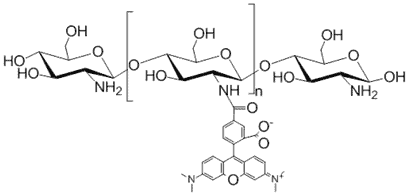Description
Chitosan is labeled with rhodamine, Ex/Em wavelength 552/575 nm. The rhodamine used in all of polysaccharide products is 5/6-carboxy-tetramethyl-rhodamine, (5/6-TAMRA). Purity: >95% powder. Standard Degree of substitution (DoS): 1 mol % substitution and at least one dye molecule per polymer. Chitosan labeled with other types of rhodamine dyes such as Texas Red, Sulforhodamine 101 is available through our custom synthesis.
Properties
Chitosan is produced by deacetylation of chitin, which is the structural element in the exoskeleton of crustaceans (such as crabs and shrimp) and cell walls of fungi. The degree of deacetylation (%DD) can be determined by NMR spectroscopy from 60 to 100%.Chitosan products are characterized by either its MW or its viscosity. The amino group in chitosan has a pKa value of ~6.5.
References
1. Chitosan-coated mesoporous MIL-100(Fe) nanoparticles as improved bio-compatible oral nanocarriers, Scientific Reports, 2017, Scientific Reports 7, Article number: 43099, Text.
2. Activity of chitosan and its derivatives against Leishmania major and L. mexicana in vitro, Antimicrob. Agents Chemother. 2020, doi:10.1128/AAC.01772-19
3. Recent advances of chitosan nanoparticles as drug carriers, Int J Nanomedicine., 2011, 6:765-74
4. Activity of Chitosan and Its Derivatives against Leishmania major and Leishmania mexicana In Vitro, Antimicrob Agents Chemother, 2020, 64:e01772-19, DOI:10.1128/AAC.01772-19.
5) Intrinsic viscosity–molecular weight relationship for chitosan, Journal of Polymer Science: Part B: Polymer Physics, Vol. 38, 2591–2598 (2000), Text. Link.
Click here to view an expanded list of hundreds of publications citing Creative PEGWorks products.


